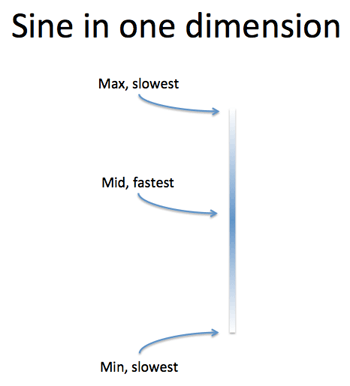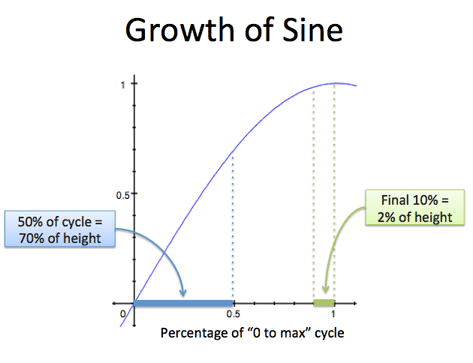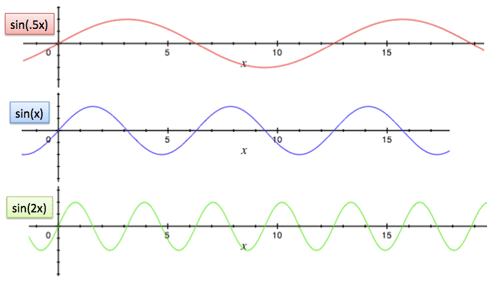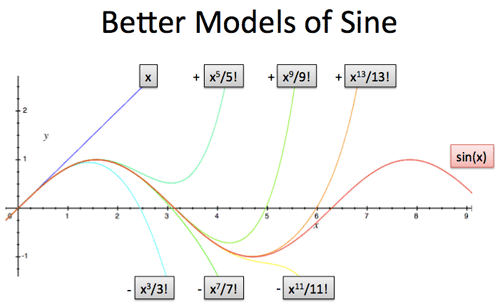
http://nbuuquang.blogspot.com/2008/12/biu-hnh-sin.html

Tôi cũng mê hội họa nên rất thích biểu đồ hình Sin, trông nó lãng mạn một cách huyền ảo. Điều lạ lùng là sau này, ra đời làm việc gì đi đâu cũng thấy nó: không những về kinh tế, chính trị mà ngay cả y học nó cũng len lỏi vào, đo điện tâm đồ, huyết áp v.v…lúc nào cũng thấy mặt nó.
Hôm nay, một ngày bù đầu, lúc giải lao ngồi uống tách trà thấy ngon quá, rồi mường tượng nó lại hiện diện: khi làm việc cật lực như lên đỉnh hình Sin, rồi thư giản là lúc xuống đáy để sẽ lên một đỉnh dốc mới.
Đó là quy luật cuộc sống, như đo điện tâm đồ khi còn hình Sin là ta còn sống, sợ nhất là sự phẳng lì".

Intuitive Understanding of Sine Waves
Sine waves confused me. Yes, I can mumble "SOH CAH
TOA" and draw lines within triangles. But what does it
mean?
I was stuck thinking sine had to be extracted from other shapes. A quick analogy:
No more. In a sentence:
Sine a natural sway, the epitome of smoothness: it makes circles "circular" in the same way lines make squares "square".
Let's build our intuition by seeing sine as its own shape, and then understand how it fits into circles and the like. Onward!
Let's observe sine in a simulator (Email readers, you may need to open the article directly):
Hubert will give the tour:
 (source)
Egads. This is the schematic diagram we've always been shown. Does it give
you the feeling of sine? Not any more than a skeleton portrays the agility of a
cat. Let's watch sine move and then chart its course.
(source)
Egads. This is the schematic diagram we've always been shown. Does it give
you the feeling of sine? Not any more than a skeleton portrays the agility of a
cat. Let's watch sine move and then chart its course.
Let's take it slow. In the simulation, set Hubert to vertical:none and horizontal: sine*. See him wiggle sideways? That's the motion of sine. There's a small tweak: normally sine starts the cycle at the neutral midpoint and races to the max. This time, we start at the max and fall towards the midpoint. Sine that "starts at the max" is called cosine, and it's just a version of sine (like a horizontal line is a version of a vertical line).
Ok. Time for both sine waves: put vertical as "sine" and horizontal as "sine*". And... we have a circle!
A horizontal and vertical "spring" combine to give circular motion. Most textbooks draw the circle and try to extract the sine, but I prefer to build up: start with pure horizontal or vertical motion and add in the other.
Sine really is 1-dimensional
Sine wiggles in one dimension. Really. We often graph sine over time (so we don't write over ourselves) and sometimes the "thing" doing sine is also moving, but this is optional! A spring in one dimension is a perfectly happy sine wave.
 Circles are an example of two sine waves
Circles are an example of two sine waves
Circles and square are a combination of basic components (sines and lines). But circles aren't the "origin" of sines any more than squares are the root cause of lines.
What do the values of sine mean?
Sine cycles between -1 and 1. It starts at 0, grows to 1.0 (max), dives to -1.0 (min) and returns to neutral. I also see sine like a percentage, from 100% (full steam ahead) to -100% (full retreat).
What's is the input 'x' in sin(x)?
Tricky question. Sine is a cycle and x, the input, is how far along we are in the cycle.
Let's look at lines:

For the geeks: Press "show stats" in the simulation. You'll see the percent complete of the total cycle, mini-cycle (0 to 1.0), and the value attained so far. Stop, step through, and switch between linear and sine motion to see the values.
Quick quiz: What's higher, 10% of a linear cycle, or 10% of a sine cycle? Sine. Remember, it barrels out of the gate at max speed. The average speed is indeed hit at 50% of the cycle time, but in the beginning we're going faster than average.
So x is the 'amount of your cycle'. What's the cycle?
It depends on the context.
<a href="http://instacalc.com/?d=&c=Ly8gZW50ZXIgYW5nbGUgaW4gZGVncmVlc3x4ID0gNDV8c2luKHgpIC8vIGhlaWdodHx8Ly8gZGVzaXJlZCBoZWlnaHQgKC0xIHRvIDEpfGhlaWdodCA9IC41fGFzaW4oaGVpZ2h0KSAvLyBhbmdsZSBuZWVkZWR8fHw&s=ssssssssss&v=0.9">calculation</a> powered by <a href="http://instacalc.com">InstaCalc Online Calculator</a>
But again, cycles depend on circles! Can we escape their tyranny?
Let's step back a bit. Sine is a repeating pattern, which means it must... repeat! It goes from 0, to 1, to 0, to -1, to 0, and so on.
Let's define pi as the time sine takes from 0 to 1 and back to 0. Whoa! Now we're using pi without a circle too! Pi is a concept that just happens to show up in circles:
Question: If pi is half of a natural cycle, why does it go on forever (i.e., irrational)?
Can I answer a question with a question? Why does the diagonal of a "unit square" have length sqrt(2), which also goes on forever?
But yes, I realize it's philosophically inconvenient when nature behaves randomly. I don't have a good intuition.


 Voila! A circle containing all possible right triangles (since they can be
scaled up using similarity). For example:
Voila! A circle containing all possible right triangles (since they can be
scaled up using similarity). For example:
Realistically, for many problems we go into "geometry mode" and start thinking "sine = height" to speed through things. That's fine -- just don't get stuck there.
Glad to rile you up. Here's the circle-less secret of sine:
Sine is acceleration opposite to your current position
Using our bank account metaphor: Imagine a perverse boss who gives you a raise the exact opposite of your current bank account! If you have $50 in the bank, then your raise next week is -$50. Of course, your income might be $75/week, so you'll still be earning some money ($75 - $50 for that week), but eventually your balance will decrease as the "raises" overpower your income.
But never fear! Once your account hits negative (say you're at -$50), then your boss gives a legit $50/week raise. Again, your income might be negative, but eventually the raises will overpower it.
This constant pull towards the center keeps the cycle going: when you rise up, the "pull" conspires to pull you in again. It also explains why neutral is the max speed for sine: If you are at the max, you begin falling and accumulating more and more "negative raises" as you plummet. As you pass through then neutral point you are feeling all the negative raises possible (once you cross, you'll start getting positive raises and slowing down).
By the way: since sine is acceleration opposite to your current position, and a circle is made up of a horizontal and vertical sine... you got it! Circular motion can be described as "a constant pull opposite your current position, towards your horizontal and vertical center".
 Seeing how acceleration impacts distance is like seeing how a raise hits your
bank account. The "raise" must change your income, and your income changes your
bank account (two integrals "up the chain").
Seeing how acceleration impacts distance is like seeing how a raise hits your
bank account. The "raise" must change your income, and your income changes your
bank account (two integrals "up the chain").
So, after "x" seconds we might guess that sine is "x" (initial impulse) minus x^3/3! (effect of the acceleration):
 Something's wrong -- sine doesn't nosedive! With e, we saw that "interest
earns interest" and sine is similar. The "restoring force" changes our distance
by -x^3/3!, which creates another restoring force to consider. Consider
a spring: the pull that yanks you down goes too far, which shoots you downward
and creates another pull to bring you up (which again goes too far).
Springs are crazy!
Something's wrong -- sine doesn't nosedive! With e, we saw that "interest
earns interest" and sine is similar. The "restoring force" changes our distance
by -x^3/3!, which creates another restoring force to consider. Consider
a spring: the pull that yanks you down goes too far, which shoots you downward
and creates another pull to bring you up (which again goes too far).
Springs are crazy!
We need to consider every restoring force:
 Just like e, sine can be described with an infinite equation:
Just like e, sine can be described with an infinite equation:
 I saw this formula a lot, but it only clicked when I saw sine as a
combination of an initial impulse and restoring forces. The initial
push (y = x, going positive) is eventually overcome by a restoring force (which
pulls us negative), which is overpowered by its own restoring force (which pulls
us positive), and so on.
I saw this formula a lot, but it only clicked when I saw sine as a
combination of an initial impulse and restoring forces. The initial
push (y = x, going positive) is eventually overcome by a restoring force (which
pulls us negative), which is overpowered by its own restoring force (which pulls
us positive), and so on.
A few fun notes:
 Again, we integrate -1 twice to get -x^2/2!. But this kicks off another
restoring force, and before you know it:
Again, we integrate -1 twice to get -x^2/2!. But this kicks off another
restoring force, and before you know it:

 This beauty says:
This beauty says:
And remember how sine and e are connected? Well, e^x can be be described by (equation):
 The same equation with a positive sign ("acceleration equal to your
position")! When sine is "the height of a circle" it's really hard to make the
connection to e.
The same equation with a positive sign ("acceleration equal to your
position")! When sine is "the height of a circle" it's really hard to make the
connection to e.
One of my great mathematical regrets is not learning differential equations. But I want to, and I suspect having an intuition for sine and e will be crucial.
I was stuck thinking sine had to be extracted from other shapes. A quick analogy:
You: Geometry is about shapes, lines, and so on... Alien: Oh? Can you show me a line?The frustration! Because sine is introduced with angles and circles, my brain thinks "Sine comes from circles. Circles circles circles."
You (looking around): Uh... see that brick, there? A line is one edge of that brick.
Alien: So lines are part of a shape?
You: Sort of. Yes, most shapes have lines in them. But a line is a basic concept on its own: a beam of light, a direct route on a map, or even a vector in many dimensions. You see--
Alien: Lines come from bricks. Bricks bricks bricks.
No more. In a sentence:
Sine a natural sway, the epitome of smoothness: it makes circles "circular" in the same way lines make squares "square".
Let's build our intuition by seeing sine as its own shape, and then understand how it fits into circles and the like. Onward!
Sine vs Lines
Remember to separate an idea from an example: squares are examples of lines. Sine clicked when it became its own idea, not "part of a circle."Let's observe sine in a simulator (Email readers, you may need to open the article directly):
Hubert will give the tour:
- Click start. Go, Hubert go! Notice that smooth back and forth motion? That's Hubert, but more importantly (sorry Hubert), that's sine! It's natural, the way springs bounce, pendulums swing, strings vibrate... and many things move.
- Change "vertical" to "linear". Big difference -- see how the motion gets constant and robotic, like a game of pong?
- Linear motion is constant: we go a set speed and turn around instantly. It's the unnatural motion in the robot dance (notice the linear bounce with no slowdown at 0:07, the strobing effect at :38).
- Sine changes its speed: it starts fast, slows down, stops, and speeds up again. It's the enchanting smoothness in liquid dancing (human sine wave at 0:12 and 0:23, natural bounce at :47).

The Unavoidable Circle
Circles have sine. Yes. But seeing the sine inside a circle is like getting the eggs back out of the omelette. It's all mixed together!Let's take it slow. In the simulation, set Hubert to vertical:none and horizontal: sine*. See him wiggle sideways? That's the motion of sine. There's a small tweak: normally sine starts the cycle at the neutral midpoint and races to the max. This time, we start at the max and fall towards the midpoint. Sine that "starts at the max" is called cosine, and it's just a version of sine (like a horizontal line is a version of a vertical line).
Ok. Time for both sine waves: put vertical as "sine" and horizontal as "sine*". And... we have a circle!
A horizontal and vertical "spring" combine to give circular motion. Most textbooks draw the circle and try to extract the sine, but I prefer to build up: start with pure horizontal or vertical motion and add in the other.
Quick Q & A
A few insights I missed when first learning sine:Sine really is 1-dimensional
Sine wiggles in one dimension. Really. We often graph sine over time (so we don't write over ourselves) and sometimes the "thing" doing sine is also moving, but this is optional! A spring in one dimension is a perfectly happy sine wave.

Circles and square are a combination of basic components (sines and lines). But circles aren't the "origin" of sines any more than squares are the root cause of lines.
What do the values of sine mean?
Sine cycles between -1 and 1. It starts at 0, grows to 1.0 (max), dives to -1.0 (min) and returns to neutral. I also see sine like a percentage, from 100% (full steam ahead) to -100% (full retreat).
What's is the input 'x' in sin(x)?
Tricky question. Sine is a cycle and x, the input, is how far along we are in the cycle.
Let's look at lines:
- You're traveling on a square. Each side takes 10 seconds.
- After 1 second, you are 10% complete on that side
- After 5 seconds, you are 50% complete
- After 10 seconds, you finished the side

- We're traveling on a sine wave, from 0 (neutral) to 1.0 (max). This portion takes 10 seconds.
- After 5 seconds we are... 70% complete! Sine rockets out of the gate and slows down. Most of the gains are in the first 5 seconds
- It takes 5 more seconds to get from 70% to 100%. And going from 98% to 100% takes almost a full second!
For the geeks: Press "show stats" in the simulation. You'll see the percent complete of the total cycle, mini-cycle (0 to 1.0), and the value attained so far. Stop, step through, and switch between linear and sine motion to see the values.
Quick quiz: What's higher, 10% of a linear cycle, or 10% of a sine cycle? Sine. Remember, it barrels out of the gate at max speed. The average speed is indeed hit at 50% of the cycle time, but in the beginning we're going faster than average.
So x is the 'amount of your cycle'. What's the cycle?
It depends on the context.
- Basic trig: 'x' is degrees, and a full cycle is 360 degrees
- Advanced trig: 'x' is radians (they are more natural!), and a full cycle is going around the unit circle (2*pi radians)
<a href="http://instacalc.com/?d=&c=Ly8gZW50ZXIgYW5nbGUgaW4gZGVncmVlc3x4ID0gNDV8c2luKHgpIC8vIGhlaWdodHx8Ly8gZGVzaXJlZCBoZWlnaHQgKC0xIHRvIDEpfGhlaWdodCA9IC41fGFzaW4oaGVpZ2h0KSAvLyBhbmdsZSBuZWVkZWR8fHw&s=ssssssssss&v=0.9">calculation</a> powered by <a href="http://instacalc.com">InstaCalc Online Calculator</a>
But again, cycles depend on circles! Can we escape their tyranny?
Pi without Pictures
Imagine a sightless alien who only notices shades of light and dark. Could you describe pi to him? It's hard to flicker the idea of a circle's circumference, right?Let's step back a bit. Sine is a repeating pattern, which means it must... repeat! It goes from 0, to 1, to 0, to -1, to 0, and so on.
Let's define pi as the time sine takes from 0 to 1 and back to 0. Whoa! Now we're using pi without a circle too! Pi is a concept that just happens to show up in circles:
- Sine is a gentle back and forth rocking
- Pi is the time from neutral to max and back to neutral
- n*Pi (0*Pi, 1*pi, 2*pi, and so on) are the times you are at neutral
- 2*Pi, 4*pi, 6*pi, etc. are full cycles
Question: If pi is half of a natural cycle, why does it go on forever (i.e., irrational)?
Can I answer a question with a question? Why does the diagonal of a "unit square" have length sqrt(2), which also goes on forever?
But yes, I realize it's philosophically inconvenient when nature behaves randomly. I don't have a good intuition.
How fast is sine?
I've been tricky. Previously, I said "imagine it takes sine 10 seconds from 0 to max". And now it's pi seconds from 0 to max back to 0? What gives?- sin(x) is the default, off-the-shelf sine wave, that indeed takes pi units of time from 0 to max to 0 (or 2*pi for a complete cycle)
- sin(2x) is a wave that moves twice as fast
- sin(x/2) is a wave that moves twice as slow

Part 2: Understanding the definitions of sine
That's a brainful -- take a break if you need it. Hopefully, sine is emerging as its own pattern. Now let's develop our intuition by seeing how common definitions of sine connect.Definition 1: The height of a triangle / circle!
Sine was first found in triangles. You may remember "SOH CAH TOA" as a mnemonic
- SOH: Sine is Opposite / Hypotenuse
- CAH: Cosine is Adjacent / Hypotenuse
- TOA: Tangent is Opposite / Adjacent
- Sine = Opposite
- Cosine = Adjacent

- sin(45) = .707
- Lay down a 10-foot pole and raise it 45 degrees. It is 10 * sin(45) = 7.07 feet off the ground
- An 8-foot pole would be 8 * sin(45) = 5.65 feet
Realistically, for many problems we go into "geometry mode" and start thinking "sine = height" to speed through things. That's fine -- just don't get stuck there.
Definition 2: The infinite series
I've avoided the elephant in the room: how in blazes do we actually calculate sine!? Is my calculator drawing a circle and measuring it?Glad to rile you up. Here's the circle-less secret of sine:
Sine is acceleration opposite to your current position
Using our bank account metaphor: Imagine a perverse boss who gives you a raise the exact opposite of your current bank account! If you have $50 in the bank, then your raise next week is -$50. Of course, your income might be $75/week, so you'll still be earning some money ($75 - $50 for that week), but eventually your balance will decrease as the "raises" overpower your income.
But never fear! Once your account hits negative (say you're at -$50), then your boss gives a legit $50/week raise. Again, your income might be negative, but eventually the raises will overpower it.
This constant pull towards the center keeps the cycle going: when you rise up, the "pull" conspires to pull you in again. It also explains why neutral is the max speed for sine: If you are at the max, you begin falling and accumulating more and more "negative raises" as you plummet. As you pass through then neutral point you are feeling all the negative raises possible (once you cross, you'll start getting positive raises and slowing down).
By the way: since sine is acceleration opposite to your current position, and a circle is made up of a horizontal and vertical sine... you got it! Circular motion can be described as "a constant pull opposite your current position, towards your horizontal and vertical center".
Geeking Out With Calculus
Let's describe sine with calculus. Like e, we can break sine into smaller effects:- Start at 0 and grow at unit speed
- At every instant, get pulled back by negative acceleration
- Our initial kick increases distance linearly: y (distance from center) = x (time taken)
- At any moment, we feel a restoring force of -x. We integrate twice to turn negative acceleration into distance:

So, after "x" seconds we might guess that sine is "x" (initial impulse) minus x^3/3! (effect of the acceleration):

We need to consider every restoring force:
- y = x is our initial motion, which creates a restoring force of impact:
- y = -x^3/3!, which creates a restoring force of impact:
- y = x^5/5!, which creates a restoring force of impact:
- y = -x^7/7! which creates a restoring force of impact...


A few fun notes:
- Consider the "restoring force" like "positive or negative interest". This
makes the sine/e connection in Euler's
formula easier to understand. Sine is like e, except sometimes it earns
negative interest. There's more to learn here .

- For small amounts, "y = x" is a good guess for sine. We just take the initial impulse and ignore any restoring forces.
The Calculus of Cosine
Cosine is just a shifted sine, and is fun (yes!) now that we understand sine:- Sine: Start at 0, initial impulse of y = x (100%)
- Cosine: Start at 1, no initial impulse


Definition 3: The differential equation
We've described sine's behavior with specific equations. A more succinct way (equation):
- Our current position is y
- Our acceleration (2nd derivative, or y'') is the opposite of our current position (-y)
And remember how sine and e are connected? Well, e^x can be be described by (equation):

One of my great mathematical regrets is not learning differential equations. But I want to, and I suspect having an intuition for sine and e will be crucial.
Summing it up
The goal is to move sine from some mathematical trivia ("part of a circle") to its own shape:- Sine is a smooth, swaying motion between min (-1) and max (1). Mathematically, you're accelerating opposite your position. This "negative interest" keeps sine rocking forever.
- Sine happens to appear in circles and triangles (and springs, pendulums, vibrations, sound...)
- Pi is the time from neutral to neutral in sin(x). It doesn't "belong" to circles any more than 0 and 1 do.


Không có nhận xét nào:
Đăng nhận xét